Deep at the bottom of a series of dungeons, corrupt cultists are working to bring an ancient demon back to the surface, where it has seethed, waiting for millennia for its chance to return. You and your band of Adventurers are the only thing that can stop the devastation and destruction that return will bring.
Perdition’s Mouth: Abyssal Rift (known from here on simply as Perdition’s Mouth) is a massive dungeon crawl that does away with two staples of standard Dungeons & Dragons (D&D) fare: the Dungeon Master (DM) and dice. Instead of these two seemingly essential items, the game offers a series of written scenarios that are played out across five double-sided boards, and makes use of multiple decks of cards and two rondels that govern both your actions and those of the plethora of bad guys you’ll be up against.
Sound intriguing? It should! Read on as I go into greater detail.

Greater Detail, Part One
What, no DM?
Instead of a DM, Perdition’s Mouth presents you with 32 written scenarios that introduce you to the gaming system and guide you through the dungeons.

These scenarios, which can be played as individual sessions or as part of an overall campaign, provide you with everything you’ll need to play. They start with a written introduction, detailing the setting and stating a clear goal for the session. For instance, along with the various bad guys and monstrous creatures, locked doors and spawning pits, you might also come across victims in need of rescue and/or the occasional treasure. As this is your standard, crumbling series of caverns, there will be plenty of spaces marked as difficult terrain which will cost you double the action points to move through.
The scenario cards will also tell you which monsters will be on the board at the start of the scenario and where they’re located. It will also list which creatures will be ready to spawn, and in what order, when things start to go wrong.
With the use of straightforward goals and the open monster information, players don’t need a DM to manage the story or the action.
Greater Detail, Part Two
What, No Dice?
I know, I know. I love my D&D dice. All of them. (And, yes, I have lots of them, including a set of metal dice the group I was a DM for bought me.) Just leave them all at home, kids, because you won’t need them here.
Players will start by choosing a character to play.

Characters come in the standard dungeon-crawling Adventurer classes, so you’ll want to choose these carefully.
Then, instead of dice, each player is given a deck of cards specific to the character they’re playing. They’ll shuffle their deck and draw the number of cards listed on their character sheet.
These cards will either have a numerical value or a character-specific ability. Numerical values can be played to increase movement actions, attack/defensive actions, or special abilities. If you’re nearby another character, you can even boost some of their abilities through the use of your cards.
But what about those all-important randomization rolls that give each event its own special feel? There’s a deck for that as well. With an average card draw of 2 (ranging from -1 to 4), each time you or a monster attacks, or performs certain actions, you’ll draw a card from the common Response deck.
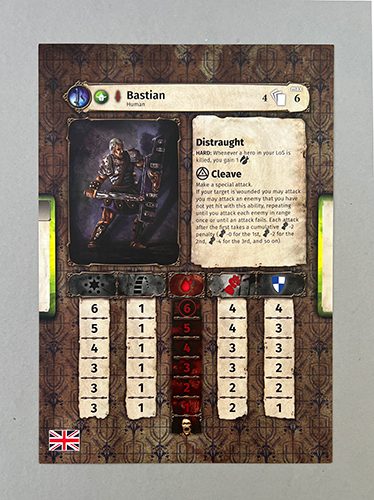
Let’s say you’re attacking a Guard with 2 hit points. As Bastian the human fighter, your attack is 4. You know you and the Guard will each be drawing a Response deck card. If the Guard draws a two, that bumps his hit points to 4—and with ties going to the defender, that would leave the Guard alive to attack you. Do you trust your draw from the Response deck to even things out? Or do you use one of your few cards to boost your attack, leaving you a card short on your next turn?
Greater Detail, Part Three
What’s a Stone of Destiny?
One of Perdition Mouth’s most discussed mechanics is the use of a rondel that governs how your party is able to take which actions: The Stone of Destiny.

The Stone of Destiny is divided into eight sections, most with more than one slot for character’s shield markers. Each character has a number of actions assigned to them on their player card. For instance, Olazabal the dwarf, starts off with four action points per turn. In the image above, his red shield is shown in the Rest section. If he wanted to Move on his next turn, it would cost him two of those actions to go clockwise around the Stone (Bash and Armed Shot are considered one section) to reach an open space on the Move section. If, instead, Olazabal wanted to Attack, it would cost him all four of his initial actions to move the four sections of the Stone to reach the Attack action.
By adding numerical cards (or special actions cards, face down for +1 each), Olazabal could either move further clockwise around the Stone to, say, reach the Defend action (for an extra 2 action points) or, when Attacking, to increase the strength of his attack.
Your cards, however, are a limited resource. Once used on a turn, they do not come back into your hand. You will need to take that Rest action, just as Olazabal had, to shuffle all his cards and then draw up a new starting hand to work with.
Oh, and don’t worry about the monsters feeling left out. They have their own rondel, The Enemy Watchstone. At the end of the Heroes’ actions, they draw a card from the Response deck and move around the Watchstone that many steps. Only, they get to take each action, one at a time, as they move.

In the photo above, if they draw a 3 from the Response deck, they’ll start by Attacking all nearby Heroes, then more creatures will spawn onto the board, followed by each creature moving towards the Heroes.
Greater Detail, Part Four
So, When Do We Level Up?
Here’s the other thing about Perdition’s Mouth: it is intentionally a hard game for the Adventurers to win. Leveling up? Nope, not gonna happen. Can I get rid of these wound cards? Not unless you have one of the two characters in your party who can perform Healing as their special actions.
To be clear: if you’re playing Perdition’s Mouth as a campaign, this means your characters will get weaker as they progress through the dungeon. Taking damage not only adds Wound cards that clog up your deck with useless (or, worse, negative) actions, but your character’s default number of actions will decrease as well. This will also hamper your ability to attack and defend yourself.
I can already hear some of you bristling at this idea. However, consider it this way: if your party was going deeper into cavernous dungeons, battling bigger and stronger creatures, you would naturally feel weaker the further on you go.
Components
There’s so much in this box that I could spend pages going over it all. Instead, I’ll hit some highlights.
Perdition’s Mouth was crowdfunded via Kickstarter and, as such, it’s one of those big box games with lots of minis. Lots of minis.
You have minis for the Heroes…
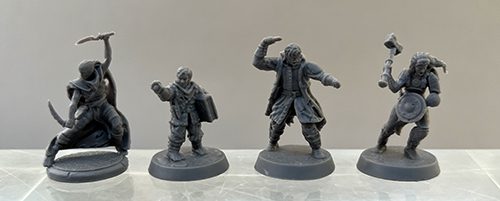
…minis for the Creatures…

…and even more minis for the Creatures.
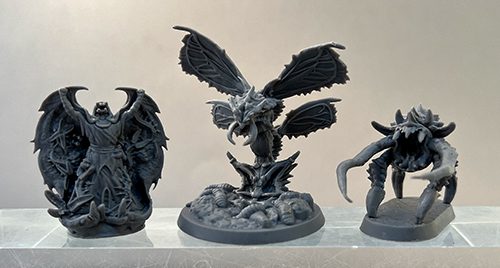
These are all standard gray plastic that came in bulging ziplock bags. For the most part they’ve held up well during playtesting, although there has been an issue with some of the Guards. They’re holding long blowguns that are supposed to stand out straight, but some of mine have remained limp, facing the floor. (Not a good look for a Guard.)
The five game boards are each double-sided and come with detailed artwork. A number and lettering system is used along the edges to ensure you’re starting each scenario with all the right items/creatures in the right places.
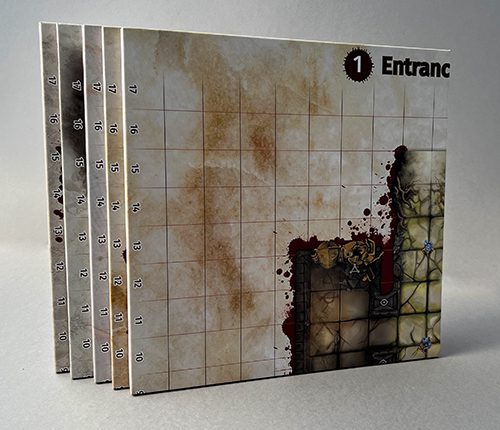
Each board looks good on the table. The intricacies of the artwork are very impressive. This is a game that takes a while to get set up, but once it’s ready to play, you know you’re in for a ride.
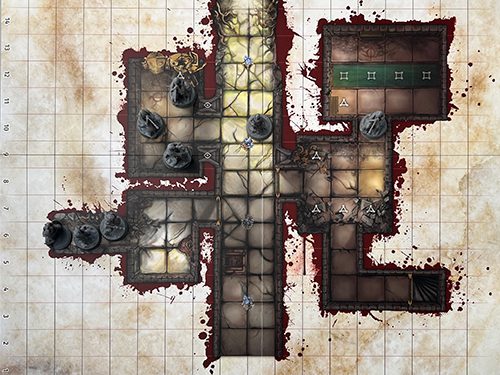
Component’s-wise, I have very few issues with Perdition’s Mouth. It’s an impressive production.
Issues
That being said, I do have a number of issues with the game.
My biggest concern is the rule book. At 42 pages, it’s overly long, struggles with clarity and organization, and tries to squeeze too much information into each page. A strip along the outside edge of each page is used to highlight certain details, often competing with the dense paragraphs in the main section of those same pages.
For some reason, the characters and monsters are shown in bright colors and viewed from above. This means trying to tell one from another is made laughably difficult.
The rule book and character cards make excessive use of iconography and, as with the minis, there’s a lot of them, too. There are so many symbols in the game that they have their own reference card.
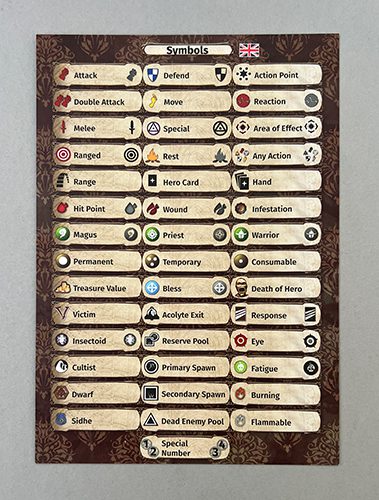
I get that the rule book is trying to get players to quickly associate a symbol with its meaning, but I find paragraphs that include the icons alongside the written meaning of those symbols to be grating.
As someone who plays and reviews a lot of games, I read a lot of rule books. This is one I tried to read on three separate occasions. Each time, I made it less than halfway through the book before giving up in confusion. Finally, I turned to online How to Play videos to learn the game.
Overall, I’m a fan of the artwork, but there’s a problem with that as well. Perdition’s Mouth is a dark game, both in theme and art. While I know dungeons are dark places, players still need to see what’s going on around them on the board. I struggled with the boards each time I played, primarily because I was playing on my kitchen table (the only table big enough for the game) at night. Even with overhead lighting, some of the areas were too dark to be easily seen. In fact, it wasn’t until I took the boards outside to take photos for this review that I was able to truly appreciate the artwork.
The lack of DM and dice comes with an important trade-off. With only ‘pre-rolled’ characters to play with set goal-driven scenarios to complete, the game lacks the collaborative, improvisational storytelling that goes on in the best roleplaying D&D sessions. (As a DM, my favorite question is, “What do you want to do next?”) That is something that, understandably, cannot be replicated here.
Final Thoughts
So, after all that, is Perdition’s Mouth worth playing?
If you’re new to D&D, this may not be the game for you. There are other games that might be an easier entry-point to a board game version of the D&D experience. (Gloomhaven: Jaws of the Lion comes to mind.) As with any D&D-like experience, scenarios in Perdition’s Mouth will not be brief affairs—you’ll need to be willing to commit 1-2 hours per scenario, with that time increasing with the number of players.
If you’re a fan of dungeon crawlers, are wary of roleplaying characters, and are willing to put the time into learning the game, then I say, Yes. Perdition’s Mouth will present you with a set of challenges that are as arduous as they are engaging. And, if the 32 scenarios in the box aren’t enough, the BoardGameGeek page for the game lists several expansions to keep the game fresh.
My sessions with the game have each felt slightly overwhelming—in that D&D, “How are we going to manage to get out of this one?”—way as various creatures quickly made each scenario more and more difficult. Teamwork is paramount to survive a given scenario, which keeps everyone involved in each part of the game. This starts with the fact that there is no set turn order, so players need to discuss their actions, determining who will do what and in which order so as to make the most efficient use of their positions around the Wheel of Destiny.
At first, I worried that Wheel was more of a gimmick than a strong mechanic. I was wrong. Rondels are nothing new to board games, but I don’t recall seeing one used in a D&D-style game before. The decisions it forces (along with the requirement to Rest to get action cards back into your hand in the midst of being attacked and/or defending) make for a unique set of decisions in this environment.
I think one of the ways Perdition’s Mouth shines brightest is in its ability to be played solo. From experience, I know it can be difficult to get a group of D&D players together on a regular basis to carry out a campaign. Here, the campaign (or one-shots) are just a box away. Given that you can replay each scenario with different characters, you have a lot of replayability both with the Easy or Hard options for each scenario, and by working out which combination of characters work best together in a given situation.
If the idea of a tough set of problem-solving dungeon challenges in the midst of crazed cultists, Insectoids and Demons sounds like fun, consider giving Perdition’s Mouth a try.




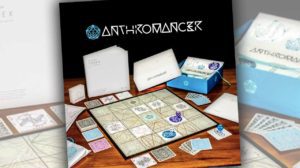

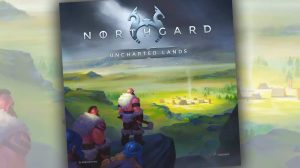
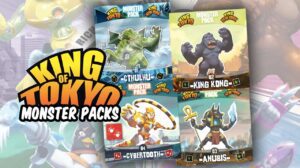




Add Comment